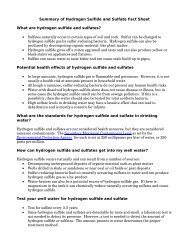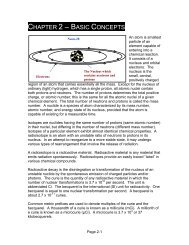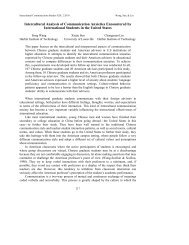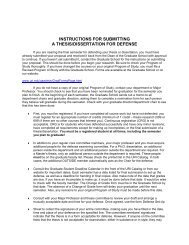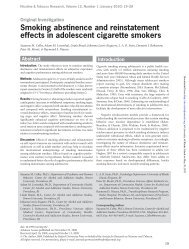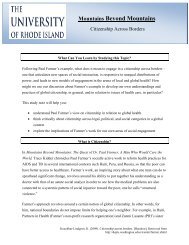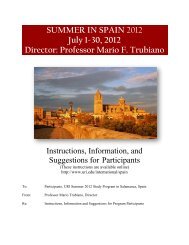Searching for Subsistence: In the Field in Pursuit... - University of ...
Searching for Subsistence: In the Field in Pursuit... - University of ...
Searching for Subsistence: In the Field in Pursuit... - University of ...
Create successful ePaper yourself
Turn your PDF publications into a flip-book with our unique Google optimized e-Paper software.
FisheriesJobAmerican Society • www.fisheries.orgCenterVOL 32 NO 12DECEMBER 2007Fish NewsLegislative UpdateJournal HighlightsCalendarResearch, Monitor<strong>in</strong>g and Evaluation <strong>of</strong> Fish and WildlifeRestoration Projects <strong>in</strong> <strong>the</strong> Columbia River Bas<strong>in</strong>:Lessons Learned and Suggestions <strong>for</strong>Large-Scale Monitor<strong>in</strong>g Programs<strong>Search<strong>in</strong>g</strong> <strong>for</strong> <strong>Subsistence</strong>:<strong>In</strong> <strong>the</strong> <strong>Field</strong> <strong>in</strong> <strong>Pursuit</strong> <strong>of</strong> an Elusive Concept<strong>in</strong> Small-scale FisheriesFisheries • VOL 32 NO 12 • DECEMBER 2007 • WWW.FISHERIES.ORG 573
FEATURE:HUMAN DIMENSIONS<strong>Search<strong>in</strong>g</strong> <strong>for</strong> <strong>Subsistence</strong>:<strong>In</strong> <strong>the</strong> <strong>Field</strong> <strong>in</strong> <strong>Pursuit</strong> <strong>of</strong> an ElusiveConcept <strong>in</strong> Small-scale FisheriesTras la subsistencia:en búsqueda de un conceptoelusivo en pesquerías artesanalesSeth Mac<strong>in</strong>ko and Sarah SchumannMac<strong>in</strong>ko is an assistant pr<strong>of</strong>essor and Schumann is an <strong>in</strong>dependent fisheries analyst at <strong>the</strong>Department <strong>of</strong> Mar<strong>in</strong>e Affairs, <strong>University</strong> <strong>of</strong> Rhode Island, K<strong>in</strong>gston. Mac<strong>in</strong>ko can be contacted at mac<strong>in</strong>ko@uri.edu..ABSTRACT: <strong>In</strong> small-scale fisheries, <strong>the</strong>re can be no morevulnerable participants than those compris<strong>in</strong>g <strong>the</strong> subsistencefish<strong>in</strong>g sector. Yet “subsistence” is an ambiguous term <strong>in</strong>fisheries management and <strong>the</strong>re is little applied researchdirected at this sector. The first step towards <strong>in</strong>corporat<strong>in</strong>gsubsistence fish<strong>in</strong>g <strong>in</strong>to <strong>for</strong>mal strategies <strong>for</strong> manag<strong>in</strong>g smallscalefisheries will be <strong>the</strong> atta<strong>in</strong>ment <strong>of</strong> a fuller understand<strong>in</strong>g<strong>of</strong> subsistence fishermen and <strong>the</strong>ir activities. This articlebuilds <strong>of</strong>f earlier work by <strong>the</strong> authors (survey<strong>in</strong>g conceptualvariation <strong>in</strong> <strong>the</strong> literature and worldwide attempts at <strong>for</strong>malmanagement regimes <strong>for</strong> subsistence fish<strong>in</strong>g) by report<strong>in</strong>g onfield ef<strong>for</strong>ts to locate and def<strong>in</strong>e subsistence fish<strong>in</strong>g activities<strong>in</strong> a specific location—Rhode Island, USA. Substantialmethodological and <strong>in</strong>stitutional challenges were encounteredand <strong>the</strong>se challenges are reviewed <strong>in</strong> terms <strong>of</strong> <strong>the</strong> implications<strong>for</strong> <strong>in</strong><strong>for</strong>med consideration <strong>of</strong> <strong>the</strong> place <strong>of</strong> subsistence fish<strong>in</strong>g<strong>in</strong> small-scale fisheries.RESUMEN: En las pesquerías artesanales, no hay participantesmás vulnerables que los que componen la división de pescade subsistencia. S<strong>in</strong> embargo “subsistencia” es un térm<strong>in</strong>oambiguo en el manejo de pesquerías y la <strong>in</strong>vestigación aplicadaa este sector es poca. El primer paso para <strong>in</strong>corporar la pescade subsistencia a las estrategias <strong>for</strong>males de manejo de la pescaartesanal será un pr<strong>of</strong>undo entendimiento de los propiospescadores y sus actividades. Este artículo canaliza el trabajoprevio de los autores (sondeando en la literatura variacionesde un concepto e <strong>in</strong>iciativas a nivel mundial para <strong>in</strong>corporarla pesca de subsistencia dentro de los regímenes <strong>for</strong>malesde pesca) mediante el reporte de trabajos en campo de laubicación y def<strong>in</strong>ición de actividades de pesca de subsistenciaen localidades particulares—Rhode Island, EEUU. Duranteeste proceso, surgieron retos metodológicos e <strong>in</strong>stitucionalesimportantes, mismos que fueron revisados en térm<strong>in</strong>os de lasimplicaciones que éstos tienen en las op<strong>in</strong>iones <strong>in</strong><strong>for</strong>madasacerca del lugar que tiene la pesca de subsistencia dentro dela pesca artesanal.<strong>Subsistence</strong> fish<strong>in</strong>g is frequentlyalluded to <strong>in</strong> <strong>in</strong>troductory fisheries textbooks,but rarely actually studied, andeven less frequently addressed <strong>in</strong> managementschemes. The existence <strong>of</strong>subsistence fish<strong>in</strong>g may pose significantimplications <strong>for</strong> management: “To a largeextent, <strong>the</strong> subsistence fishery is not be<strong>in</strong>greported <strong>in</strong> fishery statistics, monitored,assessed or regulated. If <strong>the</strong>re is <strong>in</strong>deeda significant subsistence fishery sector,this has implications <strong>for</strong> public policyregard<strong>in</strong>g resource management, allocation,impact assessment and regionaleconomic plann<strong>in</strong>g” (Berkes 1990:35).Specifically, researchers have suggestedthat subsistence fish<strong>in</strong>g may call <strong>for</strong> a differentk<strong>in</strong>d <strong>of</strong> management: “Moreover,<strong>the</strong> methods employed to manage subsistence,recreational, small-scale and<strong>in</strong>dustrial commercial fisheries are likelyto differ substantially, and until <strong>the</strong>sesectors are recognized and characterized,appropriate approaches are unlikely tobe <strong>for</strong>malized" (Branch et al. 2002a:477;c.f. Berkes 1990). <strong>In</strong> part, <strong>the</strong> belief thatit may be important to dist<strong>in</strong>guish subsistencefish<strong>in</strong>g from o<strong>the</strong>r k<strong>in</strong>ds <strong>of</strong> fish<strong>in</strong>gseems to be <strong>in</strong><strong>for</strong>med by a concernthat <strong>the</strong> groups <strong>in</strong>volved are marg<strong>in</strong>al,vulnerable populations—but researchersrout<strong>in</strong>ely acknowledge that this cannotbe confirmed because so little <strong>for</strong>malresearch is directed towards subsistencefish<strong>in</strong>g (Berkes 1990; Harris et al. 2002).<strong>In</strong> our view, <strong>the</strong> way <strong>for</strong>ward is relativelyclear. The research communitymust learn more about both <strong>the</strong> character<strong>of</strong> subsistence fish<strong>in</strong>g (how different is it,if at all, from o<strong>the</strong>r <strong>for</strong>ms <strong>of</strong> fish<strong>in</strong>g coveredby exist<strong>in</strong>g management categories)and how extensive is it. Only this can<strong>in</strong><strong>for</strong>m decisions as to whe<strong>the</strong>r dist<strong>in</strong>ctmanagement measures are called <strong>for</strong> <strong>in</strong>particular contexts.592 Fisheries • VOL 32 NO 12 • DECEMBER 2007 • WWW.FISHERIES.ORG
This article presents <strong>the</strong> results <strong>of</strong> fieldresearch focused on a simple exploratoryresearch question: is subsistence fish<strong>in</strong>goccurr<strong>in</strong>g <strong>in</strong> <strong>the</strong> coastal waters <strong>of</strong> RhodeIsland? We chose to study <strong>the</strong> coastalwaters <strong>of</strong> Rhode Island based on convenience,but we expect that our f<strong>in</strong>d<strong>in</strong>gswill have relevance <strong>for</strong> a broader researchcommunity. <strong>Subsistence</strong> fish<strong>in</strong>g is beg<strong>in</strong>n<strong>in</strong>gto attract <strong>the</strong> attention <strong>of</strong> some fisherymanagers and researchers <strong>in</strong> <strong>the</strong> NewEngland region <strong>of</strong> <strong>the</strong> United States, whoharbor <strong>the</strong> <strong>in</strong>tuitions that <strong>the</strong>re may bea <strong>for</strong>m <strong>of</strong> fish<strong>in</strong>g that is nei<strong>the</strong>r strictlycommercial nor recreational and that aseparate management category may bewarranted. We wanted to assess <strong>the</strong>se<strong>in</strong>tuitions and evaluate <strong>the</strong> potential <strong>of</strong><strong>the</strong> <strong>the</strong>oretical constructs present <strong>in</strong> <strong>the</strong>subsistence literature to be constructivelyapplied to fisheries management.PREVIOUS RESEARCHON SUBSISTENCE ANDSUBSISTENCE FISHINGOur ostensibly simple research questionimmediately becomes more complexwhen <strong>the</strong> ambiguity <strong>of</strong> <strong>the</strong> term“subsistence” is factored <strong>in</strong>. How doesone determ<strong>in</strong>e whe<strong>the</strong>r subsistence fish<strong>in</strong>gis occurr<strong>in</strong>g, if <strong>the</strong> mean<strong>in</strong>g <strong>of</strong> termitself is elusive? To address this difficulty,we based <strong>the</strong> current project onprevious <strong>the</strong>oretical work. Previously,we attempted to decipher <strong>the</strong> manymean<strong>in</strong>gs <strong>of</strong> “subsistence” <strong>in</strong> <strong>the</strong> academicliterature and reviewed <strong>the</strong> fewknown attempts at <strong>for</strong>mal management<strong>of</strong> subsistence fish<strong>in</strong>g (Schumann andMac<strong>in</strong>ko 2007). We used this survey <strong>of</strong><strong>the</strong>oretical work on subsistence to guide<strong>for</strong>mulation <strong>of</strong> our research questionsand exam<strong>in</strong>ed exist<strong>in</strong>g reports <strong>of</strong> subsistencefish<strong>in</strong>g, pay<strong>in</strong>g close attention to<strong>the</strong> motivations underly<strong>in</strong>g <strong>the</strong>se studiesand <strong>the</strong> methodologies employed.How Do They Def<strong>in</strong>e <strong>Subsistence</strong>?A simple def<strong>in</strong>ition <strong>of</strong> subsistence fisheriesis “local, non-commercial fisheries,oriented not primarily towards recreationbut <strong>for</strong> <strong>the</strong> procurement <strong>of</strong> fish <strong>for</strong> consumption<strong>of</strong> <strong>the</strong> fishers, <strong>the</strong>ir families, andcommunity" (Berkes 1988:319; 1990:35).Academic literature rarely reflects sucha simple def<strong>in</strong>ition, perhaps because <strong>the</strong>reality <strong>of</strong> subsistence fish<strong>in</strong>g itself is notso straight<strong>for</strong>ward. Academic ef<strong>for</strong>ts toelaborate more specific def<strong>in</strong>itions havegiven rise to four broad categories <strong>of</strong>mean<strong>in</strong>g, which we present as alternatedef<strong>in</strong>itions <strong>of</strong> <strong>the</strong> term:1. <strong>Subsistence</strong>: economic activities orsystems susta<strong>in</strong><strong>in</strong>g a basic level <strong>of</strong>livelihood, not pr<strong>of</strong>it (Sahl<strong>in</strong>s 1972;Eversole 2003);2. <strong>Subsistence</strong>: economies based on shar<strong>in</strong>g,not sell<strong>in</strong>g (Young et al. 1994);3. <strong>Subsistence</strong>: social and cultural <strong>in</strong>stitutionssupported by an economy <strong>of</strong>non-market distribution (Wenzel1991; Freeman 1993; NRC 1999);and4. <strong>Subsistence</strong>: culturally significantfood-produc<strong>in</strong>g and distribut<strong>in</strong>g activities(Toth and Brown 1997; Brown etal. 1998; Brown and Toth 2001).While <strong>the</strong>se four def<strong>in</strong>itions no doubtshare a common orig<strong>in</strong>, and may evenrepresent po<strong>in</strong>ts along an evolutionarypath, <strong>the</strong>y are used concurrentlytoday <strong>in</strong> different bodies <strong>of</strong> literature,and are clearly at odds with each o<strong>the</strong>r.<strong>Subsistence</strong> fish<strong>in</strong>g, def<strong>in</strong>ed to mirror<strong>the</strong>se different mean<strong>in</strong>gs <strong>of</strong> “subsistence,”’can be construed as fish<strong>in</strong>g <strong>for</strong>Sarah Schumann <strong>in</strong>terviews <strong>the</strong> owner<strong>of</strong> Ocean State Tackle, a key <strong>in</strong><strong>for</strong>mant.Fisheries • VOL 32 NO 12 • DECEMBER 2007 • WWW.FISHERIES.ORG 593
livelihood ra<strong>the</strong>r than pr<strong>of</strong>it, regardless<strong>of</strong> whe<strong>the</strong>r <strong>the</strong> catch is eaten or sold(def<strong>in</strong>ition 1); fish<strong>in</strong>g where catch isdistributed through non-market mechanisms,regardless <strong>of</strong> <strong>the</strong> economic level<strong>of</strong> <strong>the</strong> fisherman (def<strong>in</strong>ition 2); fish<strong>in</strong>gundertaken to support traditionalexchange structures, whe<strong>the</strong>r or not it isdone <strong>in</strong> <strong>the</strong> context <strong>of</strong> a market economy(def<strong>in</strong>ition 3); or fish<strong>in</strong>g characterizedby its cultural significance, whe<strong>the</strong>rit is a community or an <strong>in</strong>dividual activity(def<strong>in</strong>ition 4).Why and How Do TheyStudy <strong>Subsistence</strong>?Empirical studies <strong>of</strong> subsistence haveshown no more <strong>of</strong> a propensity to con<strong>for</strong>mto a s<strong>in</strong>gle mold than <strong>the</strong> <strong>the</strong>oreticalwork def<strong>in</strong><strong>in</strong>g “subsistence.” <strong>Subsistence</strong>studies can be grouped by geographicalarea and by <strong>the</strong> way <strong>the</strong>y def<strong>in</strong>e “subsistence,”s<strong>in</strong>ce <strong>the</strong> def<strong>in</strong>itions summarizedabove tend to be l<strong>in</strong>ked with certa<strong>in</strong>global locations. Motivations <strong>for</strong> study<strong>in</strong>gsubsistence vary accord<strong>in</strong>gly.The longest-runn<strong>in</strong>g history <strong>of</strong> subsistenceresearch is associated with Alaskaand o<strong>the</strong>r areas <strong>of</strong> <strong>the</strong> Arctic, and focuses<strong>for</strong> <strong>the</strong> most part on <strong>the</strong> activities <strong>of</strong><strong>in</strong>digenous populations. <strong>In</strong> Alaska, <strong>the</strong>impetus <strong>for</strong> <strong>the</strong>se studies is <strong>the</strong> found<strong>in</strong>gmandate <strong>of</strong> <strong>the</strong> <strong>Subsistence</strong> Division<strong>of</strong> <strong>the</strong> Alaska Department <strong>of</strong> Fish andGame: “compile exist<strong>in</strong>g data and conductstudies...on all aspects <strong>of</strong> <strong>the</strong> role<strong>of</strong> subsistence hunt<strong>in</strong>g and fish<strong>in</strong>g on<strong>the</strong> lives <strong>of</strong> <strong>the</strong> residents <strong>of</strong> <strong>the</strong> state”(State <strong>of</strong> Alaska <strong>Subsistence</strong> Law 1978).Most <strong>of</strong> <strong>the</strong> work produced by this entityfalls under <strong>the</strong> head<strong>in</strong>g <strong>of</strong> “harvest studies”—<strong>in</strong>ventories<strong>of</strong> <strong>the</strong> production andconsumption <strong>of</strong> wild foods at <strong>the</strong> communitylevel, measured usually <strong>in</strong> weightby species, with <strong>the</strong> purpose <strong>of</strong> enabl<strong>in</strong>gbetter management (Wolfe and Walker1987; Fall 1990; Usher et al. 2003).O<strong>the</strong>r studies <strong>in</strong> Alaska, Canada, andGreenland have focused on historicaltrends <strong>in</strong> <strong>the</strong> importance and mean<strong>in</strong>g<strong>of</strong> subsistence <strong>for</strong> Native peoples (examplesare Kruse 1991; Caulfield 1993). <strong>In</strong>particular, <strong>the</strong> branch <strong>of</strong> “acculturationstudies” has aimed to document changesthat occur as traditional structures come<strong>in</strong>to contact with <strong>the</strong> market economy(Chance 1987). These studies assume adef<strong>in</strong>ition <strong>of</strong> subsistence <strong>in</strong> l<strong>in</strong>e with oursecond and third def<strong>in</strong>itions above, but<strong>the</strong> word itself is rarely def<strong>in</strong>ed, though<strong>the</strong>re is an implicit l<strong>in</strong>k to <strong>in</strong>digenouspopulations.For a long time, subsistence studieswere exclusively <strong>the</strong> doma<strong>in</strong> <strong>of</strong> Arcticresearchers, but more recently, it hasbeen alleged that subsistence is muchmore widespread and merits broader<strong>in</strong>vestigation (Berkes 1990). This propositionhas been met with a variety <strong>of</strong>field research projects with<strong>in</strong> <strong>the</strong> last fewyears.An <strong>in</strong>terest<strong>in</strong>g case is <strong>the</strong> processundertaken by South Africa’s Mar<strong>in</strong>eand Coastal Management agency toidentify subsistence fishermen <strong>in</strong> thatcountry. A basic premise <strong>of</strong> this researchwas that “[w]hile a priori clarity on <strong>the</strong>def<strong>in</strong>ition would ideally have provideda common understand<strong>in</strong>g and basis <strong>for</strong>fur<strong>the</strong>r work...it was recognized that <strong>the</strong>precise def<strong>in</strong>ition <strong>of</strong> ‘subsistence’ wouldhave to emerge from <strong>the</strong> process itself"(Harris et al. 2002:411). Thus, anyonewho was not unmistakably a commercialor recreational fisherman was <strong>in</strong>cluded<strong>in</strong> <strong>the</strong> study (Hauck et al. 2002), so as“not to prejudge <strong>the</strong>ir legitimacy as subsistencefishers" (Harris et al. 2002:411).Fishermen (note that we use <strong>the</strong> term“fishermen,” except where directly quot<strong>in</strong>go<strong>the</strong>rs, <strong>in</strong> deference to <strong>the</strong> vernacular<strong>of</strong> our study area) were asked whe<strong>the</strong>r<strong>the</strong>y considered <strong>the</strong>mselves subsistencefishermen, and if not, what dist<strong>in</strong>guished<strong>the</strong>m from subsistence fishermen (Harriset al. 2002). Responses led researchersto conclude that <strong>the</strong>ir orig<strong>in</strong>al generalizationsabout how and why subsistencefishermen fished—such as use <strong>of</strong> fish <strong>for</strong>consumption and reliance on hand-madegear—had been fairly fallacious (Clarket al. 2002; Branch et al. 2002b).A third category <strong>of</strong> subsistence researchhas emerged <strong>in</strong> rural regions <strong>of</strong> <strong>the</strong> UnitedStates, and <strong>in</strong>cludes two studies <strong>of</strong> fish<strong>in</strong>gand hunt<strong>in</strong>g <strong>in</strong> <strong>the</strong> Mississippi delta(Brown et al. 1998; Brown and Toth2001) and one <strong>of</strong> huckleberry collect<strong>in</strong>g<strong>in</strong> Wash<strong>in</strong>gton and Idaho (Carroll etal. 2003). Like <strong>the</strong> South African case,<strong>the</strong>se researchers opted not to narrowlydef<strong>in</strong>e subsistence at <strong>the</strong> outset but to leta context-appropriate def<strong>in</strong>ition emergethrough <strong>the</strong> <strong>in</strong>terview process. Brown etal. (1998) pioneered a def<strong>in</strong>ition-4 typeuse <strong>of</strong> <strong>the</strong> word “subsistence” to describeharvest motivations ly<strong>in</strong>g outside <strong>the</strong>strictly commercial and <strong>the</strong> strictly recreational,recogniz<strong>in</strong>g that until <strong>the</strong>n <strong>the</strong>term had been used only to describe <strong>the</strong>activities <strong>of</strong> “extraord<strong>in</strong>ary groups,” suchas Native Americans, while <strong>the</strong> comparableterm “<strong>in</strong><strong>for</strong>mal economy” had beenused to describe <strong>the</strong> same activities whenper<strong>for</strong>med by familiar groups. Believ<strong>in</strong>gthat “limit<strong>in</strong>g explanations <strong>of</strong> <strong>the</strong> participation<strong>of</strong> non-extraord<strong>in</strong>ary groups<strong>in</strong> mixed economies to <strong>the</strong> conceptualumbrella <strong>of</strong> <strong>in</strong><strong>for</strong>mal economy mayobfuscate some <strong>in</strong>terest<strong>in</strong>g aspects <strong>of</strong> <strong>the</strong>social side <strong>of</strong> such activities” (Brown etal. 1998:605), <strong>the</strong>y undertook to answer<strong>the</strong> question: “Are <strong>the</strong>re two conceptuallydist<strong>in</strong>ct dimensions—lifestyle choiceand economic strategy—to <strong>the</strong> activitiesmeasured <strong>in</strong> <strong>the</strong> Mississippi Delta, <strong>the</strong>reby<strong>in</strong>dicat<strong>in</strong>g a good fit with <strong>the</strong> concept <strong>of</strong>subsistence?” (Brown et al. 1998:611).Brown et al. (1998) refer to non-commercialfish<strong>in</strong>g out <strong>of</strong> economic necessityas an activity that falls under <strong>the</strong> <strong>in</strong><strong>for</strong>maleconomy label, reserv<strong>in</strong>g <strong>the</strong> label"subsistence” <strong>for</strong> non-commercial fish<strong>in</strong>gmotivated by culture and tradition.Carroll et al. (2003) set out not tostudy subsistence per se but to categorizetypes <strong>of</strong> users <strong>of</strong> <strong>the</strong> natural resources <strong>in</strong>question—huckleberries. Their objectivewas to resolve <strong>the</strong> “label<strong>in</strong>g question”—aconcern that <strong>for</strong>c<strong>in</strong>g all activities <strong>in</strong>toei<strong>the</strong>r <strong>the</strong> recreational or <strong>the</strong> commerciallabels oversimplifies motives. This group<strong>of</strong> researchers co<strong>in</strong>cided with <strong>the</strong> SouthAfrican commitment to “use <strong>the</strong> <strong>in</strong>terview<strong>in</strong>gprocess itself to identify relevantcategories” (Carroll et al. 2003:323).METHODOLOGYFish<strong>in</strong>g is a particularly <strong>in</strong>terest<strong>in</strong>g type<strong>of</strong> resource use <strong>in</strong> that it can be done commerciallyas a full-time job, recreationallyas a leisure activity, or—as alleged <strong>in</strong> subsistencestudies—<strong>for</strong> <strong>the</strong> atta<strong>in</strong>ment <strong>of</strong>food and/or cultural benefits. Thus, <strong>the</strong>only failsafe way to discern whe<strong>the</strong>r afisherman is a subsistence fisherman is, as<strong>the</strong> South African study illustrates, to ask.But <strong>of</strong> course, this implies that some def<strong>in</strong>ition<strong>of</strong> subsistence is known by <strong>the</strong> fisherman(and presumably communicated to<strong>the</strong> researcher). <strong>In</strong> areas where <strong>the</strong> term“subsistence” is not widely used, it is moreappropriate to survey <strong>the</strong> motivations <strong>of</strong>different fishermen, as <strong>in</strong> <strong>the</strong> studies <strong>of</strong><strong>the</strong> rural United States, and <strong>the</strong>n determ<strong>in</strong>ewhe<strong>the</strong>r any <strong>of</strong> <strong>the</strong>se motivationscan be called “subsistence.”594 Fisheries • VOL 32 NO 12 • DECEMBER 2007 • WWW.FISHERIES.ORG
For our study, we adopted an <strong>in</strong>ductivestrategy that shared several similaritieswith <strong>the</strong> approaches <strong>of</strong> researchers <strong>in</strong>South Africa and <strong>the</strong> rural United States.We addressed <strong>the</strong> issue <strong>of</strong> <strong>the</strong> multiplemean<strong>in</strong>gs <strong>of</strong> “subsistence” by divid<strong>in</strong>g ourresearch question <strong>in</strong>to two: (1) are <strong>the</strong>reany activities occurr<strong>in</strong>g <strong>in</strong> Rhode Islandthat could be called “subsistence fish<strong>in</strong>g”under any <strong>of</strong> <strong>the</strong> academic mean<strong>in</strong>gs surveyed<strong>in</strong> Schumann and Mac<strong>in</strong>ko (2007;reviewed above), and (2) do <strong>the</strong> <strong>in</strong>dividualspractic<strong>in</strong>g <strong>the</strong>se activities call <strong>the</strong>m“subsistence fish<strong>in</strong>g” or do <strong>the</strong>y haveo<strong>the</strong>r terms to describe <strong>the</strong>ir activities?We used a two-tiered <strong>in</strong>terviewapproach consist<strong>in</strong>g on one level <strong>of</strong> <strong>in</strong>terviewswith “key <strong>in</strong><strong>for</strong>mants,” and on <strong>the</strong>second level, <strong>in</strong>terviews with fishermen<strong>the</strong>mselves (c.f. Brown and Toth 2001;Branch et al. 2002b; Harris et al. 2002).We did not supply respondents witha def<strong>in</strong>ition <strong>of</strong> subsistence <strong>in</strong> advance(c.f. Brown and Toth 2001; Harris et al.2002; Hauck et al. 2002) and we directly<strong>in</strong>quired about motivations (c.f. Carrollet al. 2003).Whom Do We Target?Our key <strong>in</strong><strong>for</strong>mants were people weselected based on a snowball sampl<strong>in</strong>gtechnique (referrals from one key <strong>in</strong><strong>for</strong>mantto <strong>the</strong> next) and based on <strong>the</strong>assumption that <strong>the</strong>y might know morethan most people about subsistence fish<strong>in</strong>g<strong>in</strong> Rhode Island. Of <strong>the</strong> 21 people weselected as key <strong>in</strong><strong>for</strong>mants, 2 were fisheriesen<strong>for</strong>cement agents, 2 were journalistsspecializ<strong>in</strong>g <strong>in</strong> fish<strong>in</strong>g, 1 was a fisherymanager, 1 was an academic who hadpreviously supervised research on consumption<strong>of</strong> contam<strong>in</strong>ated fish <strong>in</strong> RhodeIsland, 2 were party or charter boat owner/capta<strong>in</strong>s, 1 was <strong>the</strong> president <strong>of</strong> <strong>the</strong> localrecreational fish<strong>in</strong>g organization, and 12were bait shop owners/managers.<strong>In</strong> <strong>the</strong> second phase <strong>of</strong> our research,we <strong>in</strong>terviewed 63 fishermen. Some werecontacted at bait shops but most werefound fish<strong>in</strong>g from shore, <strong>in</strong>clud<strong>in</strong>g severaldigg<strong>in</strong>g <strong>for</strong> clams, several jigg<strong>in</strong>g<strong>for</strong> squid, and o<strong>the</strong>rs target<strong>in</strong>g a variety<strong>of</strong> f<strong>in</strong>fish. Our <strong>in</strong>terviews were spreadthroughout <strong>the</strong> days <strong>of</strong> <strong>the</strong> week, fairwea<strong>the</strong>r and foul, and from early morn<strong>in</strong>gto midnight.<strong>In</strong> <strong>the</strong> Arctic studies <strong>of</strong> subsistence,where a pre<strong>for</strong>med legal def<strong>in</strong>ition andlong-term association <strong>of</strong> <strong>the</strong> term with<strong>in</strong>digenous populations have been <strong>in</strong>fluential,researchers seem to have had littledifficulty identify<strong>in</strong>g subsistence resourceusers. <strong>In</strong> <strong>the</strong> absence <strong>of</strong> such def<strong>in</strong>itionsand preconceptions, it is more difficult top<strong>in</strong>po<strong>in</strong>t who counts as a subsistence userand who does not. Where an economicdef<strong>in</strong>ition <strong>of</strong> “subsistence” is paramount,as <strong>in</strong> <strong>the</strong> South African study, potentialsubsistence fishermen must be, first and<strong>for</strong>emost, poor, <strong>in</strong> order to qualify <strong>for</strong><strong>in</strong>clusion <strong>in</strong> a subsistence study. Wheresubsistence is presumed to have a culturaldef<strong>in</strong>ition, as <strong>in</strong> <strong>the</strong> studies <strong>of</strong> subsistenceharvest<strong>in</strong>g <strong>in</strong> <strong>the</strong> rural United States,limited superficial criteria are available<strong>for</strong> identify<strong>in</strong>g subsistence harvesters.S<strong>in</strong>ce <strong>the</strong> object <strong>of</strong> our study was todetect anyth<strong>in</strong>g that could be labeledsubsistence under any one <strong>of</strong> <strong>the</strong> def<strong>in</strong>itions<strong>in</strong> our typology, we were look<strong>in</strong>g <strong>for</strong>anyone who:1. Catches fish to sell or eat out <strong>of</strong> economicnecessity;2. Catches fish to exchange or give away<strong>in</strong> order to ma<strong>in</strong>ta<strong>in</strong> desired structures<strong>of</strong> distribution, as ei<strong>the</strong>r an economicor a social strategy; or3. Catches fish to ma<strong>in</strong>ta<strong>in</strong> culture andtradition.S<strong>in</strong>ce a fisherman’s motivation is notdiscernible from his appearance, thismeant essentially <strong>in</strong>terview<strong>in</strong>g everyonewe found fish<strong>in</strong>g, with <strong>the</strong> exception <strong>of</strong>large-scale commercial fishermen andobvious “sport” fishermen who practice<strong>Subsistence</strong> fish<strong>in</strong>g from charter/party boats?Future research should pay moreattention to this possibility.catch-and-release, s<strong>in</strong>ce <strong>the</strong>se fishermenwould not fit under any def<strong>in</strong>ition <strong>of</strong>subsistence.What Do We Ask?With key <strong>in</strong><strong>for</strong>mants, we began our<strong>in</strong>terviews by ask<strong>in</strong>g whe<strong>the</strong>r <strong>the</strong>y werefamiliar with <strong>the</strong> term “subsistence.” If<strong>the</strong>y were not, we asked <strong>the</strong>m whe<strong>the</strong>r<strong>the</strong>y knew <strong>of</strong> anyone who “fishes <strong>for</strong>food.” If <strong>the</strong>y were familiar with “subsistence,”we asked what <strong>the</strong> term meantto <strong>the</strong>m and whe<strong>the</strong>r <strong>the</strong>y thought itoccurred <strong>in</strong> coastal Rhode Island. We<strong>the</strong>n asked <strong>the</strong>m to specify differencesbetween recreational and subsistence (orfood) fish<strong>in</strong>g, and between commercialand subsistence (or food) fish<strong>in</strong>g. F<strong>in</strong>ally,we asked <strong>the</strong>m to provide us with a list<strong>of</strong> “clues” that we could use to identifysubsistence fishermen: who <strong>the</strong>y tend tobe, locations where <strong>the</strong>y tend to fish, andspecies <strong>the</strong>y tend to catch. Their answersto this last part were ma<strong>in</strong>ly used to comeup with a list <strong>of</strong> sites to target, as well asto get a description <strong>of</strong> <strong>the</strong>ir sense <strong>of</strong> <strong>the</strong>subsistence universe.Our strategy <strong>for</strong> <strong>in</strong>terview<strong>in</strong>g fishermen<strong>the</strong>mselves was quite different. Weavoided us<strong>in</strong>g <strong>the</strong> word “subsistence”entirely, beg<strong>in</strong>n<strong>in</strong>g <strong>the</strong> dialogue <strong>in</strong>steadwith <strong>the</strong> question “Why do you fish?”We <strong>the</strong>n asked <strong>the</strong>m whe<strong>the</strong>r <strong>the</strong>y atewhat <strong>the</strong>y caught and what else <strong>the</strong>y didwith it (did <strong>the</strong>y sell it, give it away, orsave it?). Several questions were gearedtowards discrim<strong>in</strong>at<strong>in</strong>g between subsis-Fisheries • VOL 32 NO 12 • DECEMBER 2007 • WWW.FISHERIES.ORG 595
tence and o<strong>the</strong>r fishermen and amongdifferent types (accord<strong>in</strong>g to differentdef<strong>in</strong>itions <strong>of</strong> subsistence <strong>in</strong> <strong>the</strong> literature)<strong>of</strong> subsistence fishermen. To gaugeeconomic motivation (<strong>in</strong> support <strong>of</strong>def<strong>in</strong>ition 1-type subsistence fish<strong>in</strong>g), weasked whe<strong>the</strong>r <strong>the</strong>y saved money by fish<strong>in</strong>g,whe<strong>the</strong>r <strong>the</strong>y would still fish even ifit were more expensive to catch fish thanto buy <strong>the</strong>m, and whe<strong>the</strong>r it mattered to<strong>the</strong>m if <strong>the</strong>y caught noth<strong>in</strong>g. To gauge<strong>the</strong> importance <strong>of</strong> culture and tradition<strong>in</strong> fish<strong>in</strong>g (which would suggest <strong>the</strong> existence<strong>of</strong> def<strong>in</strong>ition 3- and 4-type subsistencefish<strong>in</strong>g) we asked <strong>the</strong>m how long<strong>the</strong>y had been fish<strong>in</strong>g and where/how<strong>the</strong>y learned to fish. We also asked about<strong>the</strong> motivations <strong>of</strong> o<strong>the</strong>r fishermen, andwhe<strong>the</strong>r <strong>the</strong>y believe <strong>the</strong>re are differentcategories <strong>of</strong> fishermen.FINDINGSWe have organized our f<strong>in</strong>d<strong>in</strong>gs by <strong>the</strong>questions asked. Some questions wereposed only to one group (e.g., only to key<strong>in</strong><strong>for</strong>mants) whereas o<strong>the</strong>rs were asked <strong>of</strong>everyone.Familiarity with “<strong>Subsistence</strong>”Seven <strong>of</strong> our 21 key <strong>in</strong><strong>for</strong>mants hadnever heard <strong>the</strong> term “subsistence.”Of those who had, <strong>the</strong> range <strong>of</strong> <strong>the</strong>irresponses when asked to def<strong>in</strong>e subsistencewas narrower than <strong>in</strong> <strong>the</strong> academicliterature on subsistence—most key<strong>in</strong><strong>for</strong>mants answered that subsistence was“fish<strong>in</strong>g where <strong>the</strong> primary motivation isto catch food,” some add<strong>in</strong>g that it is done<strong>for</strong> survival, or at least that it accounts <strong>for</strong>a significant portion <strong>of</strong> <strong>the</strong> fishermen’sdiets. S<strong>in</strong>ce so many were unfamiliar with<strong>the</strong> term “subsistence,” we asked what abetter term would be to describe fish<strong>in</strong>gwith any <strong>of</strong> <strong>the</strong> motivations described <strong>in</strong><strong>the</strong> academic literature—hesitant suggestions<strong>in</strong>cluded “fishery-dependent” and“meat fish<strong>in</strong>g.”Why Do People (<strong>Subsistence</strong>) Fish?The motivation <strong>for</strong> <strong>the</strong> k<strong>in</strong>d <strong>of</strong> fish<strong>in</strong>gmentioned above, accord<strong>in</strong>g to a few <strong>of</strong>our key <strong>in</strong><strong>for</strong>mants, was food provision<strong>in</strong>g.But several o<strong>the</strong>rs saw a dual motivation,where fun was just as importantas food <strong>in</strong> motivat<strong>in</strong>g fishermen to fish.Only one <strong>in</strong><strong>for</strong>mant cited what could becalled a “cultural” motivation, evocative<strong>of</strong> def<strong>in</strong>itions number 3 and 4 <strong>of</strong> ourtypology.Tak<strong>in</strong>g a warn<strong>in</strong>g from Brown etal.’s observation that “at times cleardemarcations <strong>in</strong> mean<strong>in</strong>g between<strong>the</strong>se doma<strong>in</strong>s—recreation and subsistence—couldnot be made ei<strong>the</strong>r by <strong>the</strong>fishers <strong>the</strong>mselves or by <strong>the</strong> researchers”(Brown et al. 1998:613), we asked all key<strong>in</strong><strong>for</strong>mants to dist<strong>in</strong>guish between <strong>the</strong>setwo types <strong>of</strong> fish<strong>in</strong>g. Many perceived nodifference—as one <strong>of</strong> our <strong>in</strong><strong>for</strong>mantsemphatically stated when asked to supplya dist<strong>in</strong>ct label <strong>for</strong> fish<strong>in</strong>g <strong>for</strong> food, “wecall that fish<strong>in</strong>g; it’s just fish<strong>in</strong>g.” Thosewho did perceive a difference statedei<strong>the</strong>r that recreational fishermen were<strong>in</strong> pursuit <strong>of</strong> fun—not food—or that subsistencefishermen were unique <strong>in</strong> <strong>the</strong>irdependence on catch.The dist<strong>in</strong>ction between subsistenceand commercial seemed to be more clearcut<strong>for</strong> our <strong>in</strong><strong>for</strong>mants, who ma<strong>in</strong>ta<strong>in</strong>edthat commercial fish<strong>in</strong>g was done <strong>for</strong> saleand subsistence was done <strong>for</strong> <strong>the</strong> table—but one bait shop owner told us that itwas common practice among his customersto <strong>in</strong><strong>for</strong>mally sell extra fish to contactswho owned restaurants.Asked whe<strong>the</strong>r subsistence fish<strong>in</strong>goccurred <strong>in</strong> Rhode Island, <strong>the</strong> key <strong>in</strong><strong>for</strong>mantswere not at all <strong>in</strong> agreement: manyresponded that subsistence did not occur<strong>in</strong> Rhode Island, while o<strong>the</strong>rs simply hadno idea. Still o<strong>the</strong>rs suspected, but couldnot confirm, that it occurred, and onestated a firm belief that it is widespreadyet undocumented. We heard severalviews that no one <strong>in</strong> Rhode Island whomight fall <strong>in</strong>to a subsistence categoryactually depends on fish<strong>in</strong>g, but an equalnumber <strong>of</strong> respondents <strong>in</strong>dicated that certa<strong>in</strong>groups (most notably <strong>the</strong> Asian ethnicgroup) fished <strong>for</strong> economic necessity.Even though not all <strong>in</strong><strong>for</strong>mants agreedthat people fish<strong>in</strong>g <strong>for</strong> food were dependenton <strong>the</strong>ir catch <strong>for</strong> survival, mostconcurred <strong>in</strong> <strong>the</strong> belief that fish<strong>in</strong>g waseconomically rational, or that it couldbe made so by pool<strong>in</strong>g resources such asvehicles used to access fish<strong>in</strong>g sites.Of <strong>the</strong> 63 fishermen we talked to, 12could not be considered subsistence fishermenby any criterion because <strong>the</strong>y released<strong>the</strong> fish that <strong>the</strong>y caught. Among thosewho consumed <strong>the</strong>ir catch, most werefish<strong>in</strong>g <strong>for</strong> reasons that could be termed“recreation”: fun, relaxation, escape, andsport. However, we also heard some motivationsthat could fit under an economicnecessity def<strong>in</strong>ition <strong>of</strong> “subsistence”:• By fish<strong>in</strong>g, I get it fresh—even if itwere cheaper to buy fish, I wouldn’t—fish at <strong>the</strong> store comes frozen, and whoknows how long ago it was caught orwhere it’s even from?• I’m on a special diet where I have toeat lots <strong>of</strong> fish....my Social Securitydoesn’t stretch far enough [to buy fish];it’s cheaper to catch <strong>the</strong>m.• You learn how to catch fish, so if oneday you don’t have any money you’llknow how to survive.While <strong>the</strong> responses above emphasizeself-provision<strong>in</strong>g, three fishermen admittedto sell<strong>in</strong>g catch as a sidel<strong>in</strong>e <strong>in</strong>come.One said:• I sell it. My friends buy it from me. Isell it to feed my family, and we eatsome <strong>of</strong> it too. I have a steady job butfish<strong>in</strong>g supplements it. It’s like a hobbybut if you catch someth<strong>in</strong>g you canmake a few bucks <strong>of</strong>f it.<strong>In</strong>terest<strong>in</strong>gly, only two <strong>of</strong> <strong>the</strong> o<strong>the</strong>r<strong>in</strong>terviewees believed that it was possibleto save money by fish<strong>in</strong>g. O<strong>the</strong>r responseswere consistent with a cultural <strong>in</strong>terpretation<strong>of</strong> “subsistence”:• When you’re an <strong>In</strong>dian, you’re supposedto fish. [Q: Is it tradition or recreation?]It’s both—really <strong>the</strong>re’s nodifference at all between recreationand tradition. For both, it’s aboutpeace <strong>of</strong> m<strong>in</strong>d.• I fish <strong>for</strong> bait and food. I like to makeall different k<strong>in</strong>ds <strong>of</strong> food, like Ch<strong>in</strong>esefood, deep-fried fish, soup…I could goon and on. I take all <strong>the</strong> fish I catch,and what I don’t eat I share withfriends.• Some people come to ‘bond’ and socializetoge<strong>the</strong>r. It’s ‘<strong>the</strong> fish<strong>in</strong>g clan.’• We come here once a year and campand dig clams. We did this as kidsand now we’re repeat<strong>in</strong>g it with ourfamilies.• I dig [clams] <strong>for</strong> fun and exercise. Ialways come <strong>the</strong> third week <strong>in</strong> June,from Rehoboth, Massachusetts. Icamp nearby and friends stop by <strong>for</strong>cookouts. I share with <strong>the</strong>m.596 Fisheries • VOL 32 NO 12 • DECEMBER 2007 • WWW.FISHERIES.ORG
Who is <strong>Subsistence</strong> Fish<strong>in</strong>g?The most common <strong>the</strong>me that could be called “cultural”was <strong>the</strong> notion that motivation <strong>for</strong> fish<strong>in</strong>g, as well as speciestargeted, is culturally and ethnically determ<strong>in</strong>ed. We did notask <strong>in</strong><strong>for</strong>mants to differentiate between ethnic groups, but<strong>in</strong>variably <strong>the</strong> answer to <strong>the</strong> “Who is fish<strong>in</strong>g <strong>for</strong> subsistence?”question elicited descriptions couched <strong>in</strong> ethnic terms. Asianand Lat<strong>in</strong>o immigrants, we were repeatedly told, fish <strong>for</strong> food,<strong>of</strong>ten depend<strong>in</strong>g on it <strong>for</strong> sustenance, while whites fish <strong>for</strong> fun.Scup, we were told, “is a black fish,” while Lat<strong>in</strong>os like bluefish,and Asians go after squid, scup, tautog, fluke, shellfish (“evenperiw<strong>in</strong>kles”)—as several <strong>in</strong><strong>for</strong>mants exclaimed, “Asians eatanyth<strong>in</strong>g!”While we found no obvious association between ethnicityand motivation <strong>for</strong> fish<strong>in</strong>g, it is notable that representation<strong>of</strong> non-white groups <strong>in</strong> our sample is disproportionately largewhen compared to <strong>the</strong> general population <strong>of</strong> Rhode Island. Ofthose fishermen we <strong>in</strong>terviewed, 36% were white (compared to<strong>the</strong> 85% <strong>of</strong> Rhode Island residents that are white), 13% wereblack (compared to 4.5% <strong>of</strong> <strong>the</strong> general population), 23% wereAsian (compared to 2% <strong>of</strong> <strong>the</strong> general population), and 28%were Lat<strong>in</strong>o (compared to 9% <strong>of</strong> <strong>the</strong> general population).Although few <strong>of</strong> <strong>the</strong> fishermen we talked with told us <strong>the</strong>y aremotivated primarily by a need <strong>for</strong> food, many made reference too<strong>the</strong>r fishermen who are. Confirm<strong>in</strong>g what <strong>the</strong> key <strong>in</strong><strong>for</strong>mantssaid, fishermen reported that <strong>the</strong>se groups are “ethnic”:• Ch<strong>in</strong>ese do it <strong>for</strong> food—it’s culture <strong>for</strong> <strong>the</strong>m.• Some do it to eat daily—<strong>the</strong> Portuguese do this.• People do fish <strong>for</strong> food here, you see <strong>the</strong>m <strong>in</strong> big familygroups. Mostly Sou<strong>the</strong>ast Asians.We encountered a widely held belief that people fish<strong>in</strong>g <strong>for</strong>food do not respect size limits. Two explanations were <strong>of</strong>fered <strong>in</strong>support <strong>of</strong> this view: one position was that it is due to culture—immigrants are accustomed to fish<strong>in</strong>g <strong>in</strong> absence <strong>of</strong> regulationsso <strong>the</strong>y have not adapted to <strong>the</strong> laws <strong>of</strong> this country—while <strong>the</strong>o<strong>the</strong>r is economic—“if you’re from a poor country, you can’tconceive <strong>of</strong> throw<strong>in</strong>g back a short.”Several <strong>in</strong><strong>for</strong>mants asserted that fish<strong>in</strong>g was someth<strong>in</strong>g thatimmigrant groups had brought with <strong>the</strong>m from <strong>the</strong>ir nativecountries, and one alleged that immigrants’ adherence to <strong>the</strong>tradition <strong>of</strong> fish<strong>in</strong>g decl<strong>in</strong>ed with time spent liv<strong>in</strong>g <strong>in</strong> thiscountry. <strong>In</strong><strong>for</strong>mants added that <strong>the</strong>se immigrant groups werenot locally based, but came from surround<strong>in</strong>g states, as far awayas New Hampshire, to catch fish <strong>in</strong> Rhode Island. As <strong>for</strong> genderand age, we were told that whole families fished toge<strong>the</strong>r—“from grandmo<strong>the</strong>rs down to five-year-olds” —to <strong>in</strong>crease <strong>the</strong>number <strong>of</strong> bag limits <strong>the</strong>y could take home <strong>in</strong> a day.Where Does <strong>Subsistence</strong> Fish<strong>in</strong>g Occur?Our last question—“Where do people fish when fish<strong>in</strong>g <strong>for</strong>food?”—met with mixed responses. Many <strong>in</strong><strong>for</strong>mants ma<strong>in</strong>ta<strong>in</strong>edthat this type <strong>of</strong> fish<strong>in</strong>g occurs only from shore, though afew (<strong>in</strong>clud<strong>in</strong>g a party boat owner) stated that it is quite prevalenton party boats, and some were familiar with cases <strong>of</strong> foodfish<strong>in</strong>g occurr<strong>in</strong>g from privately owned boats (“sometimes you’llsee 9 people <strong>in</strong> a 15-foot boat fish<strong>in</strong>g <strong>for</strong> scup”).Fisheries • VOL 32 NO 12 • DECEMBER 2007 • WWW.FISHERIES.ORG 597
DISCUSSIONDid We F<strong>in</strong>d <strong>Subsistence</strong>?Did we f<strong>in</strong>d anyth<strong>in</strong>g that could becalled “subsistence” under any <strong>of</strong> <strong>the</strong>four def<strong>in</strong>itions we located <strong>in</strong> <strong>the</strong> literature?The answer to date has to be “notreally.” We did not f<strong>in</strong>d anyone actuallyfish<strong>in</strong>g <strong>for</strong> livelihood, and <strong>the</strong> fact thatonly two fishermen stated that it was possibleto save money by catch<strong>in</strong>g (ra<strong>the</strong>rthan buy<strong>in</strong>g) fish <strong>in</strong>dicates that an economicnecessity def<strong>in</strong>ition <strong>of</strong> subsistence(def<strong>in</strong>ition 1) is not widely applicable to<strong>the</strong> fishermen we encountered. However,quite a few <strong>of</strong> our key <strong>in</strong><strong>for</strong>mants told us adifferent story, some claim<strong>in</strong>g that fishermendepend on <strong>the</strong>ir catch <strong>for</strong> food andmany more affirm<strong>in</strong>g that fish<strong>in</strong>g could bepart <strong>of</strong> a household budget strategy.We did not f<strong>in</strong>d anyone fish<strong>in</strong>g to supporta network <strong>of</strong> food distribution basedon shar<strong>in</strong>g (def<strong>in</strong>ition 2). Although severalrespondents mentioned shar<strong>in</strong>g catch,none declared it as his primary motivation<strong>for</strong> fish<strong>in</strong>g. A few <strong>of</strong> <strong>the</strong> fishermen’sresponses allowed <strong>for</strong> an <strong>in</strong>terpretationcorrespond<strong>in</strong>g to a cultural def<strong>in</strong>ition <strong>of</strong>subsistence, as <strong>in</strong> def<strong>in</strong>itions 3 and 4, but<strong>the</strong> questions we asked were not specificenough to dist<strong>in</strong>guish between motivationsparticular to subsistence and morenuanced motivations <strong>of</strong> recreationalfish<strong>in</strong>g.At this po<strong>in</strong>t, we cannot say thatwe have found activity that is differentenough to warrant a separate managementcategory (that is, <strong>in</strong> addition tocommercial and recreational), but wehave not concluded it does not exist.Several key <strong>in</strong><strong>for</strong>mants corroborated <strong>the</strong><strong>in</strong>tuition that <strong>the</strong>re may be a third categoryout <strong>the</strong>re. As <strong>for</strong> <strong>the</strong> nature <strong>of</strong> thisthird category, our impression is that what<strong>in</strong><strong>for</strong>mants associate with “subsistence” issometh<strong>in</strong>g along <strong>the</strong> l<strong>in</strong>es <strong>of</strong> def<strong>in</strong>ition 1(fish<strong>in</strong>g <strong>for</strong> livelihood), but with a particularemphasis on direct food procurement(as opposed to sell<strong>in</strong>g <strong>the</strong> catch). <strong>In</strong>this sense, <strong>the</strong>ir understand<strong>in</strong>g is more <strong>in</strong>l<strong>in</strong>e with <strong>the</strong> connotation <strong>of</strong> “subsistencefish<strong>in</strong>g” <strong>in</strong> everyday language—a focus onfood provision<strong>in</strong>g <strong>for</strong> direct consumption<strong>for</strong> <strong>the</strong> purpose <strong>of</strong> survival.This does not mean that subsistencefish<strong>in</strong>g a la def<strong>in</strong>ition 1 is occurr<strong>in</strong>g <strong>in</strong>Rhode Island, nor that it is <strong>the</strong> only k<strong>in</strong>d<strong>of</strong> subsistence fish<strong>in</strong>g occurr<strong>in</strong>g <strong>in</strong> RhodeIsland, nor moreover, that any <strong>for</strong>m <strong>of</strong>subsistence is occurr<strong>in</strong>g—it only serves todemonstrate what comes to m<strong>in</strong>d <strong>for</strong> peopleknowledgeable about fish<strong>in</strong>g <strong>in</strong> RhodeIsland when <strong>the</strong>y hear <strong>the</strong> word “subsistence.”But it is significant that <strong>the</strong> academicliterature does not seem to matchup with <strong>the</strong> “real world” assessments weencountered among <strong>in</strong><strong>for</strong>mants.Though <strong>the</strong> stated purpose <strong>of</strong> this projectwas to search <strong>for</strong> anyth<strong>in</strong>g that couldbe called “subsistence” accord<strong>in</strong>g to <strong>the</strong>academic literature and <strong>the</strong>n determ<strong>in</strong>ewhe<strong>the</strong>r this type <strong>of</strong> fish<strong>in</strong>g warrants aseparate management category, our f<strong>in</strong>d<strong>in</strong>gthat “subsistence,” as understood byour key <strong>in</strong><strong>for</strong>mants, may be occurr<strong>in</strong>g is<strong>in</strong> some ways even more significant: ifpeople are <strong>in</strong>deed fish<strong>in</strong>g <strong>for</strong> food, out<strong>of</strong> need or as part <strong>of</strong> a household budgetstrategy, <strong>the</strong>re is a good case <strong>for</strong> adapt<strong>in</strong>gmanagement to reflect that need. Whileacademic def<strong>in</strong>ition 1 overlaps with our<strong>in</strong><strong>for</strong>mants’ understand<strong>in</strong>g <strong>of</strong> “subsistence,”much <strong>of</strong> <strong>the</strong> rest <strong>of</strong> <strong>the</strong> academicliterature is <strong>in</strong> danger <strong>of</strong> obscur<strong>in</strong>g this<strong>for</strong>m <strong>of</strong> subsistence by relegat<strong>in</strong>g it to <strong>the</strong>realm <strong>of</strong> “<strong>in</strong><strong>for</strong>mal economy.”What People "Know" versusWhat We "Found"There may be significant departuresbetween what people th<strong>in</strong>k about subsistencefish<strong>in</strong>g and what we found <strong>in</strong> <strong>the</strong>field. Below, we compare what we foundwhen <strong>in</strong>terview<strong>in</strong>g fishermen with somecomments we received from our key<strong>in</strong><strong>for</strong>mants, highlight<strong>in</strong>g some <strong>of</strong> <strong>the</strong> discrepancybetween what people “know”and what we “found.”“It’s <strong>the</strong> Asians, blacks, ethnicgroups, Portuguese”Are <strong>the</strong> viewpo<strong>in</strong>ts we encounteredamongst our key <strong>in</strong><strong>for</strong>mants accurate orare <strong>the</strong>y <strong>the</strong> product <strong>of</strong> stereotyp<strong>in</strong>g andurban mythology? We were repeatedlytold that scup <strong>in</strong> particular is a target <strong>of</strong>subsistence fishermen and that “scup isa black fish” yet one very active blackfisherman we <strong>in</strong>terviewed said he hadnever heard <strong>of</strong> scup and was surprisedwhen told <strong>of</strong> its alleged association withhis race. Similarly, Asian immigrantswere frequently cited as <strong>the</strong> archetypalsubsistence fishermen. At one bait shop,a group <strong>of</strong> Asian customers were specificallypo<strong>in</strong>ted out to us as be<strong>in</strong>g subsistencefishermen, yet when asked directlyabout <strong>the</strong>ir motivations, <strong>the</strong>y replied that<strong>the</strong>y fished <strong>for</strong> fun and released all <strong>the</strong> fish<strong>the</strong>y caught. Of course, we cannot drawany conclusions from <strong>the</strong>se two anecdotesbecause <strong>the</strong>y may represent <strong>the</strong> exceptionsto o<strong>the</strong>rwise accurate assessments.Our sample size was too small and at thispo<strong>in</strong>t we simply do not know if we endedup with anomalous cases <strong>in</strong> our sample.“Hmmm. Just what is subsistencefish<strong>in</strong>g if you can af<strong>for</strong>d to go outon a charter boat to do it?”We received this comment, clearlyimply<strong>in</strong>g a def<strong>in</strong>ition 1-type understand<strong>in</strong>g<strong>of</strong> “subsistence,” from a colleaguedur<strong>in</strong>g <strong>the</strong> plann<strong>in</strong>g stages <strong>of</strong> our project.S<strong>in</strong>ce we did not discount <strong>the</strong> possibilitythat o<strong>the</strong>r mean<strong>in</strong>gs <strong>of</strong> subsistence fish<strong>in</strong>g(such as def<strong>in</strong>itions 2, 3, and 4, whichdo not h<strong>in</strong>ge on liv<strong>in</strong>g standard) couldoccur on party/charter boats, we pursuedthis question, and found what may comeas a surprise to many: def<strong>in</strong>ition 1-typesubsistence may well occur with<strong>in</strong> <strong>the</strong>charter fish<strong>in</strong>g <strong>in</strong>dustry (we use <strong>the</strong> term“charter” generically, while not<strong>in</strong>g that<strong>the</strong> <strong>in</strong>dustry is divided <strong>in</strong>to charter andparty boat operations). The party boatowner we <strong>in</strong>terviewed stated that “10%<strong>of</strong> [his] party boat clients have to catchenough to justify go<strong>in</strong>g. They are <strong>the</strong>reto catch fish to eat.” This same key <strong>in</strong><strong>for</strong>mantmentioned people fish<strong>in</strong>g <strong>of</strong>f hisparty boats <strong>in</strong> <strong>the</strong> past <strong>in</strong> pursuit <strong>of</strong> both<strong>in</strong>come and food as part <strong>of</strong> an overallhousehold economic strategy. Def<strong>in</strong>ition1-style subsistence fish<strong>in</strong>g <strong>of</strong>f party boatshas been <strong>in</strong> documented <strong>in</strong> o<strong>the</strong>r sett<strong>in</strong>gsas well—<strong>for</strong> example, <strong>in</strong> Manhattandur<strong>in</strong>g <strong>the</strong> Great Depression: “They didmore bus<strong>in</strong>ess than any o<strong>the</strong>r party fish<strong>in</strong>gboat on Sheepshead Bay dur<strong>in</strong>g <strong>the</strong>Depression. Kev<strong>in</strong> admits that <strong>the</strong> hardtimes may have actually contributed to<strong>the</strong> bro<strong>the</strong>rs’ success: because fish wereso abundant <strong>in</strong> <strong>the</strong> area, people pooled<strong>the</strong>ir money and sent one person fromeach apartment house to go fish<strong>in</strong>g: thatperson could conceivably catch enoughfish to feed <strong>the</strong> entire build<strong>in</strong>g (Lai 2001:284).”The Challenge <strong>of</strong> MethodologyIs it possible to study someth<strong>in</strong>g withoutan operational def<strong>in</strong>ition <strong>of</strong> thatsometh<strong>in</strong>g firmly <strong>in</strong> hand? At bottom, aphilosophical clash between <strong>in</strong>ductive598 Fisheries • VOL 32 NO 12 • DECEMBER 2007 • WWW.FISHERIES.ORG
and deductive approaches is embedded<strong>in</strong> this question. A practical problem isalso <strong>in</strong>volved: how can we ever def<strong>in</strong>esubsistence, characterize subsistence use,and identify subsistence users if no contextually-relevantprior research <strong>in</strong> <strong>the</strong>area has been conducted? A too-rigid<strong>in</strong>sistence on deductive approaches seemslikely to result <strong>in</strong> no research be<strong>in</strong>g conductedat all given our present ignorance<strong>of</strong> subsistence fish<strong>in</strong>g <strong>in</strong> many locationsaround <strong>the</strong> globe.CONCLUSIONSBased on our experiences to date, webelieve that an <strong>in</strong>ductive approach is bothwarranted and effective when conduct<strong>in</strong>g<strong>in</strong>itial, exploratory research <strong>in</strong>to subsistencefish<strong>in</strong>g activities. The <strong>in</strong>troductoryquestion “Why do you fish?” proved to bea remarkably stimulat<strong>in</strong>g and unbiasedway to engage fishermen <strong>in</strong> talk about<strong>the</strong>ir motivations.We did not f<strong>in</strong>d clear cases <strong>of</strong> selfdescribedmotivations that could becalled “subsistence” under prevail<strong>in</strong>gconceptions <strong>of</strong> that term <strong>in</strong> <strong>the</strong> academicliterature. Our respondents stressed recreationalbenefits and motivations. Thisresult is consistent with o<strong>the</strong>r researchers’exam<strong>in</strong>ations <strong>of</strong> self-reported motivations(Beehler et al. 2001). However, <strong>the</strong> belief<strong>in</strong> someth<strong>in</strong>g that could be called “fishery-dependence”or “food fish<strong>in</strong>g” amongour key <strong>in</strong><strong>for</strong>mants impels us to cont<strong>in</strong>uesearch<strong>in</strong>g. We th<strong>in</strong>k this project providedsome clear suggestions as to where to focusfur<strong>the</strong>r research. We would look closely at<strong>the</strong> fishery <strong>for</strong> scup and we would pursue<strong>the</strong> possibility <strong>of</strong> subsistence fish<strong>in</strong>g (mostlikely along <strong>the</strong> l<strong>in</strong>es <strong>of</strong> def<strong>in</strong>ition 1) onparty boats. The research communitymust learn more about both <strong>the</strong> character<strong>of</strong> subsistence fish<strong>in</strong>g (how differentis it, if at all, from o<strong>the</strong>r <strong>for</strong>ms <strong>of</strong> fish<strong>in</strong>gcovered by exist<strong>in</strong>g management categories)and how extensive is it. Clearly, weencountered differences between perceptionand reality that are important to sortout prior to <strong>for</strong>mulat<strong>in</strong>g managementstrategies. Only thorough <strong>in</strong>vestigationand an appropriate methodology can<strong>in</strong><strong>for</strong>m decisions as to whe<strong>the</strong>r dist<strong>in</strong>ctmanagement measures are called <strong>for</strong> <strong>in</strong>particular contexts.REFERENCESBeehler, G. P., B. M. McGu<strong>in</strong>ness, J. E.Vena. 2001. Polluted fish, sources <strong>of</strong>knowledge, and <strong>the</strong> perception <strong>of</strong> risk:contextualiz<strong>in</strong>g African-Americananglers’ sport-fish<strong>in</strong>g practices. HumanOrganization 60 (3):288-297.Berkes, F. 1988. <strong>Subsistence</strong> fish<strong>in</strong>g <strong>in</strong>Canada: a note on term<strong>in</strong>ology. Arctic41(4):319-320.______. 1990. Native subsistence fisheries:a syn<strong>the</strong>sis <strong>of</strong> harvest studies <strong>in</strong> Canada.Arctic 43(1):35-42.Branch, G. M., M. Hauck, N. Siqwana-Ndulo, and A. H. Dye. 2002a. Def<strong>in</strong><strong>in</strong>gfishers <strong>in</strong> <strong>the</strong> South African context:subsistence, artisanal and small-scalecommercial sectors. South AfricanJournal <strong>of</strong> Mar<strong>in</strong>e Science 24:475-487.Branch, G. M., J. May, B. Roberts, B.Russell, and B. M. Clark. 2002b. Casestudies on <strong>the</strong> socio-economic characteristicsand lifestyles <strong>of</strong> subsistenceand <strong>in</strong><strong>for</strong>mal fisheries <strong>in</strong> South Africa.South African Journal <strong>of</strong> Mar<strong>in</strong>eScience 24:439-462.Brown, R. B., and J. F. Toth, Jr. 2001.Natural resource access and <strong>in</strong>terracialFisheries • VOL 32 NO 12 • DECEMBER 2007 • WWW.FISHERIES.ORG 599
associations: black and white subsistencefish<strong>in</strong>g <strong>in</strong> <strong>the</strong> Mississippi Delta.Sou<strong>the</strong>rn Rural Sociology 17:81-110.Brown, R. B., X. Xu, J. F., and Toth, Jr.1998. Lifestyle options and economicstrategies: subsistence activities <strong>in</strong><strong>the</strong> Mississippi Delta. Rural Sociology63(4):599-623.Carroll, M. S., K. A. Blatner, and P. J.Cohn. 2003. Somewhere between:social embeddedness and <strong>the</strong> spectrum<strong>of</strong> wild edible huckleberry harvest anduse. Rural Sociology 68(3):319-342.Caulfield, R. A. 1993. Aborig<strong>in</strong>al subsistencewhal<strong>in</strong>g <strong>in</strong> Greenland: <strong>the</strong> case<strong>of</strong> Qeqertarsuaq Municipality <strong>in</strong> WestGreenland. Arctic 46(2):144-155.Chance, N. A. 1987. <strong>Subsistence</strong>research <strong>in</strong> Alaska: premises, practicesand prospects. Human Organization46(1):85-89.Clark, B. M., M. Hauck, J. M. Harris,K. Salo, and E. Russell. 2002.Identification <strong>of</strong> subsistence fishers,fish<strong>in</strong>g areas, resource use and activitiesalong <strong>the</strong> South African coast. SouthAfrican Journal <strong>of</strong> Mar<strong>in</strong>e Science24:425-437.Eversole, R. 2003. My bus<strong>in</strong>ess pays me:labourers and entrepreneurs among <strong>the</strong>self-employed poor <strong>in</strong> Lat<strong>in</strong> America.Bullet<strong>in</strong> <strong>of</strong> Lat<strong>in</strong> American Research22(1):102-116.Fall, J. A. 1990. The Division <strong>of</strong><strong>Subsistence</strong> <strong>of</strong> <strong>the</strong> Alaska Department<strong>of</strong> Fish and Game: an overview <strong>of</strong>its research and f<strong>in</strong>d<strong>in</strong>gs: 1980-1990.Arctic Anthropology 27(2):68-92.Freeman, M. M. R. 1993. The <strong>In</strong>ternationalWhal<strong>in</strong>g Commission, small-typewhal<strong>in</strong>g, and com<strong>in</strong>g to terms withsubsistence. Human Organization52(3):243-251.Harris, J. M., M. Sowman, G. M. Branch,B. M. Clark, A. C. Cockcr<strong>of</strong>t, C.Coetzee, A. H. Dye, M. Hauck, A.Johnson, L. Kati-Kati, Z. Maseko, K.Salo, W. H. H. Sauer, N. Siqwana-Ndulo, and J. Beaumont. 2002. Theprocess <strong>of</strong> develop<strong>in</strong>g a managementsystem <strong>for</strong> subsistence fisheries <strong>in</strong> SouthAfrica: recogniz<strong>in</strong>g and <strong>for</strong>maliz<strong>in</strong>g amarg<strong>in</strong>alized fish<strong>in</strong>g sector <strong>in</strong> SouthAfrica. South African Journal <strong>of</strong> Mar<strong>in</strong>eSciences 24:405-424.Hauck, M., M. Sowman, E. Russell, B.M. Clark, J. M. Harris, A. Venter,J. Beaumont, and Z. Maseko. 2002.Perceptions <strong>of</strong> subsistence and <strong>in</strong><strong>for</strong>malfishers <strong>in</strong> South Africa regard<strong>in</strong>g <strong>the</strong>management <strong>of</strong> liv<strong>in</strong>g mar<strong>in</strong>e resources.South African Journal <strong>of</strong> Mar<strong>in</strong>eSciences 24:463-474.Kruse, J.A. 1991. Alaska <strong>In</strong>upiat subsistenceand wage employment patterns:understand<strong>in</strong>g <strong>in</strong>dividual choice.Human Organization 50(4):317-326.Lai, Y. S. 2001. Down to <strong>the</strong> sea <strong>in</strong> partyboats. Pages 283-284 <strong>in</strong> M. W. Robb<strong>in</strong>s,ed. Brooklyn: a state <strong>of</strong> m<strong>in</strong>d. WorkmanPublish<strong>in</strong>g, New York.NRC (National Research Council). 1999.The Community Development QuotaProgram <strong>in</strong> Alaska and lessons <strong>for</strong> <strong>the</strong>Western Pacific. National AcademyPress, Wash<strong>in</strong>gton, D.C.Sahl<strong>in</strong>s, M. 1972. Stone age economics.Ald<strong>in</strong>e A<strong>the</strong>rton, <strong>In</strong>c., Chicago.Schumann, S., and S. Mac<strong>in</strong>ko. 2007.<strong>Subsistence</strong> <strong>in</strong> coastal fisheries policy:what’s <strong>in</strong> a word? Mar<strong>in</strong>e Policy31(6):706-718.Toth, J. F., Jr., and R. B. Brown. 1997.Racial and gender mean<strong>in</strong>gs <strong>of</strong> whypeople participate <strong>in</strong> recreational fish<strong>in</strong>g.Leisure Sciences 19:129-146.Usher, P. J., G. Duhaime, and E. Searles.2003. The household as an economicunit <strong>in</strong> arctic aborig<strong>in</strong>al communities,and its measurement by means <strong>of</strong> acomprehensive survey. Social <strong>In</strong>dicatorsResearch 61:175-202.Wenzel, G. 1991. Animal rights, humanrights: ecology, economy and ideology<strong>in</strong> <strong>the</strong> Canadian Arctic. <strong>University</strong> <strong>of</strong>Toronto Press, Toronto.Wolfe, R. J., and R. J. Walker. 1987.<strong>Subsistence</strong> economies <strong>in</strong> Alaska:productivity, geography, and developmentimpacts. Arctic Anthropology24(2):56-81.Young, O. R. 1994. <strong>Subsistence</strong>, susta<strong>in</strong>ability,and sea mammals: reconstruct<strong>in</strong>g<strong>the</strong> <strong>In</strong>ternational Whal<strong>in</strong>g Regime(Commentary). Ocean and CoastalManagement 23:117-127.600 Fisheries • VOL 32 NO 12 • DECEMBER 2007 • WWW.FISHERIES.ORG



